Cognitive self check, ROCF, 25% rate, decline seen after mild COVID-19; & Spring flowers,
& welcome new readers!
I have been busy with family things and am okay. Oddly my power is out again today. So I am just touching base as I typically post daily. 📫 Update - power back on, only out a couple hours. Trees have their hazards and lowing out the local fuse was one today but all done now, one small maple removed to reduce the risk of reoccurrence.
~~
Cognitive self check - can you copy that drawing? Harder, can you draw it from memory after looking at it for a minute? Hardest, can you draw it from memory 30 minutes after you had seen it for the minute?
It is a standard cognitive screening tool which was used to screen a group of survivors of mild CoV, pre injection season - the initial illness. AND ~ 25% were found to show impairment in copying it.
Simply copying it should be fairly easy. I had seen it before when I had an all day barage of cognitive screening tests. I was asked to draw it once after the minute looking at it and I got the basic shapes and missed some of the smaller details.
Simply copying it directly, should not be that hard, mine recently. Just a freehand drawn copy:
The examples in a Tweet about the study":
See how distorted the drawings are above? While the basic shape is there, it looks squashed - visually impaired or something rather than just bad at drawing.
The Rey–Osterrieth Complex Figure Test (ROCF), dates back to 1941/1944 and is in wide use to this day to evaluate visual memory and visuospatial constructional ability (can you recreate complex shapes? can you do it from memory too?
“The Rey–Osterrieth Complex Figure Test (ROCF), which was developed by Rey in 1941 and standardized by Osterrieth in 1944, is a widely used neuropsychological test for the evaluation of visuospatial constructional ability and visual memory. Recently, the ROCF has been a useful tool for measuring executive function that is mediated by the prefrontal lobe. The ROCF consists of three test conditions: Copy, Immediate Recall and Delayed Recall. At the first step, subjects are given the ROCF stimulus card, and then asked to draw the same figure. Subsequently, they are instructed to draw what they remembered. Then, after a delay of 30 min, they are required to draw the same figure once again. The anticipated results vary according to the scoring system used, but commonly include scores related to location, accuracy and organization. Each condition of the ROCF takes 10 min to complete and the overall time of completion is about 30 min.”
(Shin, et al., 2006) Shin, MS., Park, SY., Park, SR. et al. Clinical and empirical applications of the Rey–Osterrieth Complex Figure Test. Nat Protoc 1, 892–899 (2006). https://doi.org/10.1038/nprot.2006.115 https://www.nature.com/articles/nprot.2006.115
The study & news article were shared on Twitter
https://twitter.com/tmprowell/status/1645483088284209152?t=155CcCOKF4Bx_ywHQE1qGg&s=19
The research article: (de Paula, et al., 2023) de Paula, J.J., Paiva, R.E.R.P., Souza-Silva, N.G. et al. Selective visuoconstructional impairment following mild COVID-19 with inflammatory and neuroimaging correlation findings. Mol Psychiatry 28, 553–563 (2023). https://doi.org/10.1038/s41380-022-01632-5 https://www.nature.com/articles/s41380-022-01632-5
The disturbing part is not just a ~ 25% rate of impairment among the study participants, but also, that the participants were largely a group of health professionals, average age (38.17 +- 9.82 years) - educated, cognitively gifted on average, rather than cognitively impaired as a baseline. It was also specifically, “mild COVID-19”, rather than people who might have been put on a vent or Remdesivir, potentially.
“Our sample (n = 192) was predominantly female (n = 71%), relatively young (on average 38.17 ± 9.82 years), highly educated (66% with a college degree or post graduation) and average socioeconomic status according to Brazilian standards (62%). Regarding the COVID-19 infection 6% were referred to hospitalization during the acute phase of the disease. The most reported symptoms were headache (77%), myalgia (68%) and anosmia (64%).” {…}
“Regarding cognitive changes, 51% of our sample reported subjective daily problems with thinking/or memory, 39% problems with judgment and 34% in remembering appointments.” (de Paula, et al., 2023)
As a baseline, 5-8% of people typically are not able to accurately copy the complex Rey–Osterrieth Complex Figure Test (ROCF) drawing - but that is less than 25%. Paraphrased Tweet: https://twitter.com/tmprowell/status/1645383623049113603?t=tfZ7jYEO_c9jkO_enS7VOw&s=19
The news article about the study performed in Brazil shared in that Twitter Thread: https://www.brainfacts.org/diseases-and-disorders/covid-19/2023/the-risks-of-even-mild-covid19-1-in-4-showing-cognitive-deficits-011723#.ZDNC_dg2T9o.twitter
Note: I can not make links work or reduce photo size when writing on my phone. Addition - but I could have fixed more of the typos.
In other news, while the best time to plant a tree was 20 years ago, the best time to plant spring bulbs was 40 years ago because then they naturalize - spread all over the yard and even into the woods (it helps to not mow very often).
The flower bed, above, driveway below,
A walkway that drains from the driveway and flowerbed area. The little blue, scilla I think, are everywhere! It is like a fairyland in the spring!
And into the woods with something that looks like a small hyacinth.
Tangent - how to protect tulips from deer? Plant daffodils instead - inedible for deer.
Tulips or lilies or hosta, need a deer fence.
The deer do nibble the scilla but there are so many it doesn't seem to matter.
Happy spring!
Disclaimer: This information is being shared for educational purposes within the guidelines of Fair Use and is not intended to provide individual health guidance.





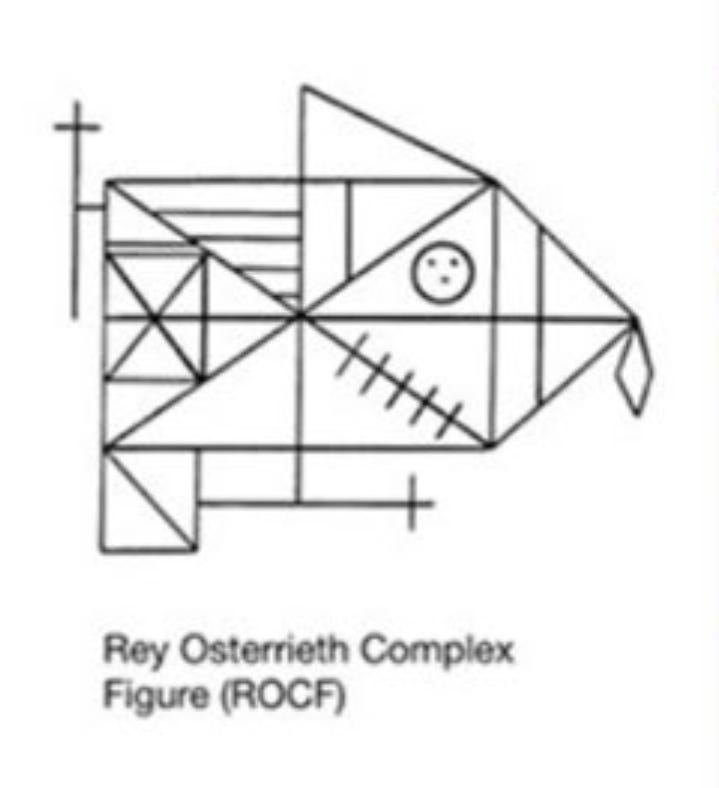
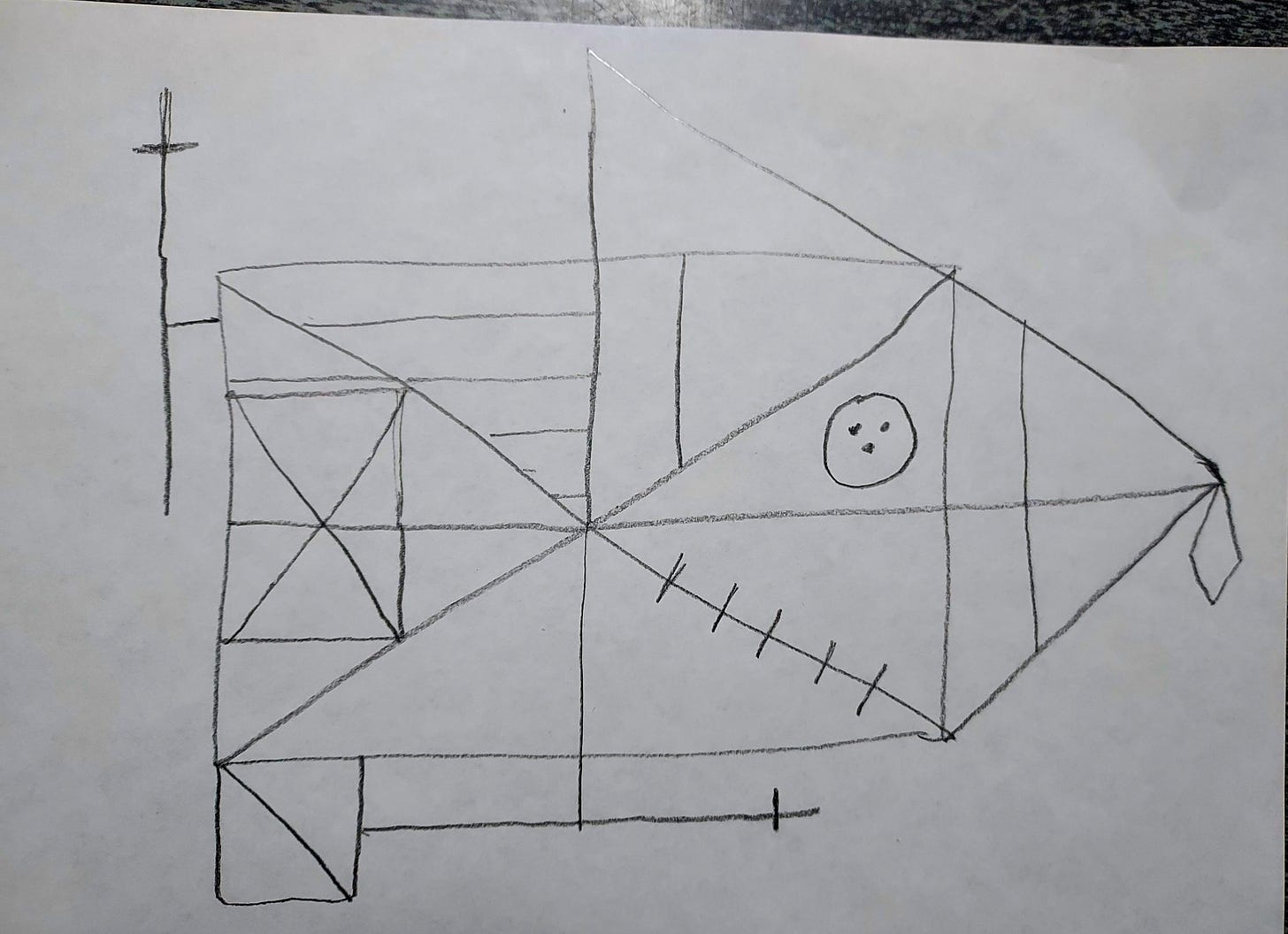

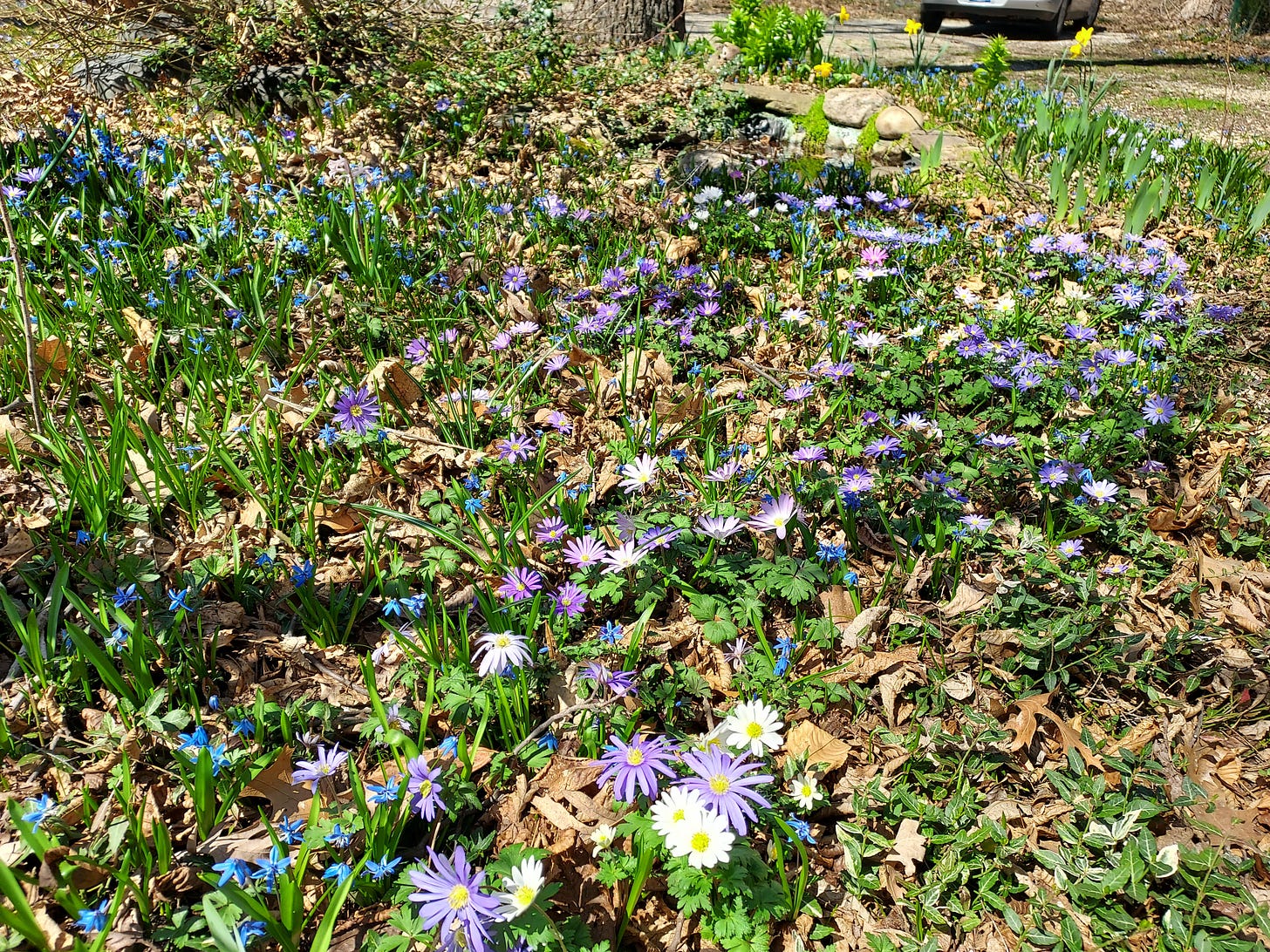
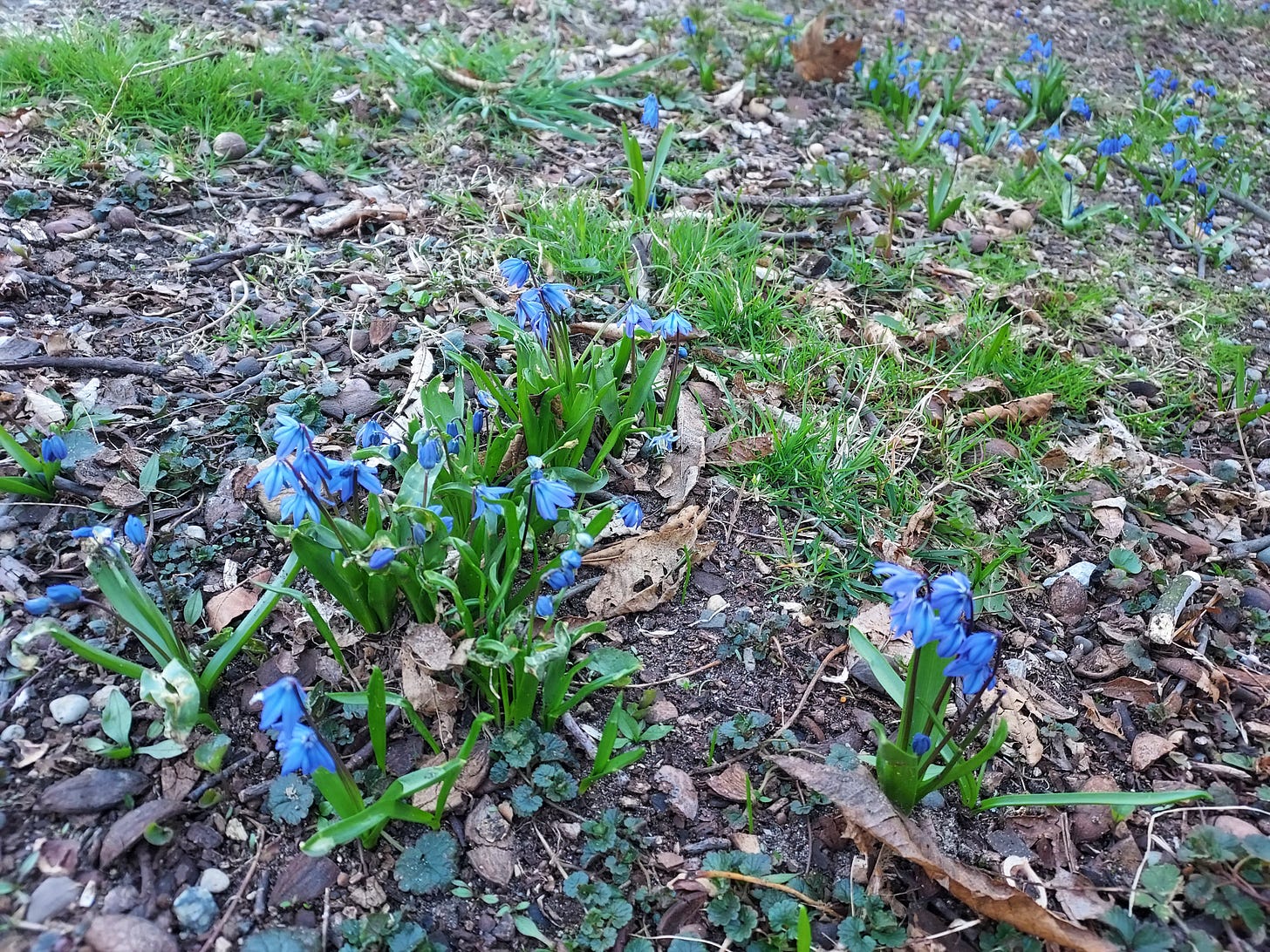
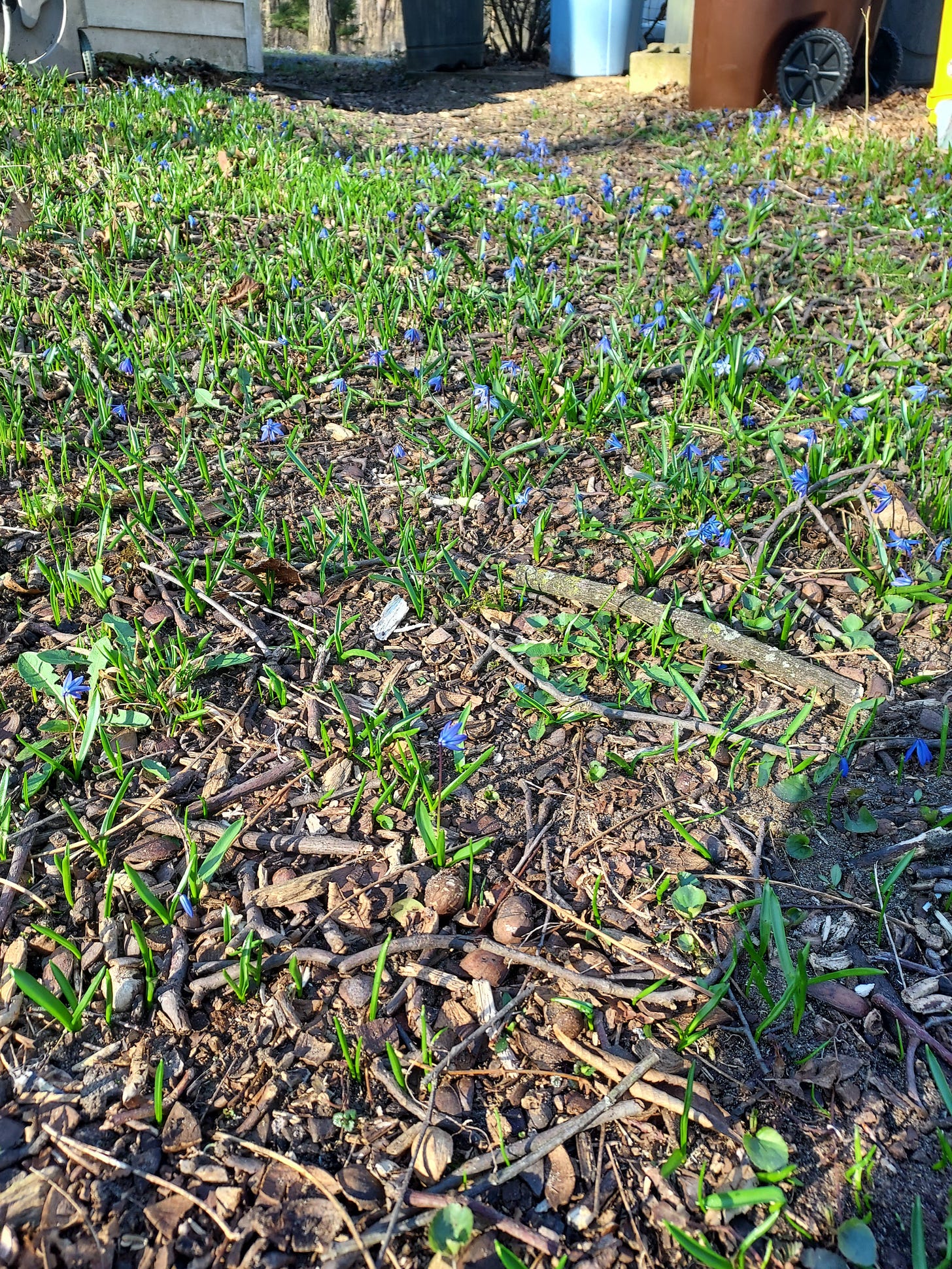
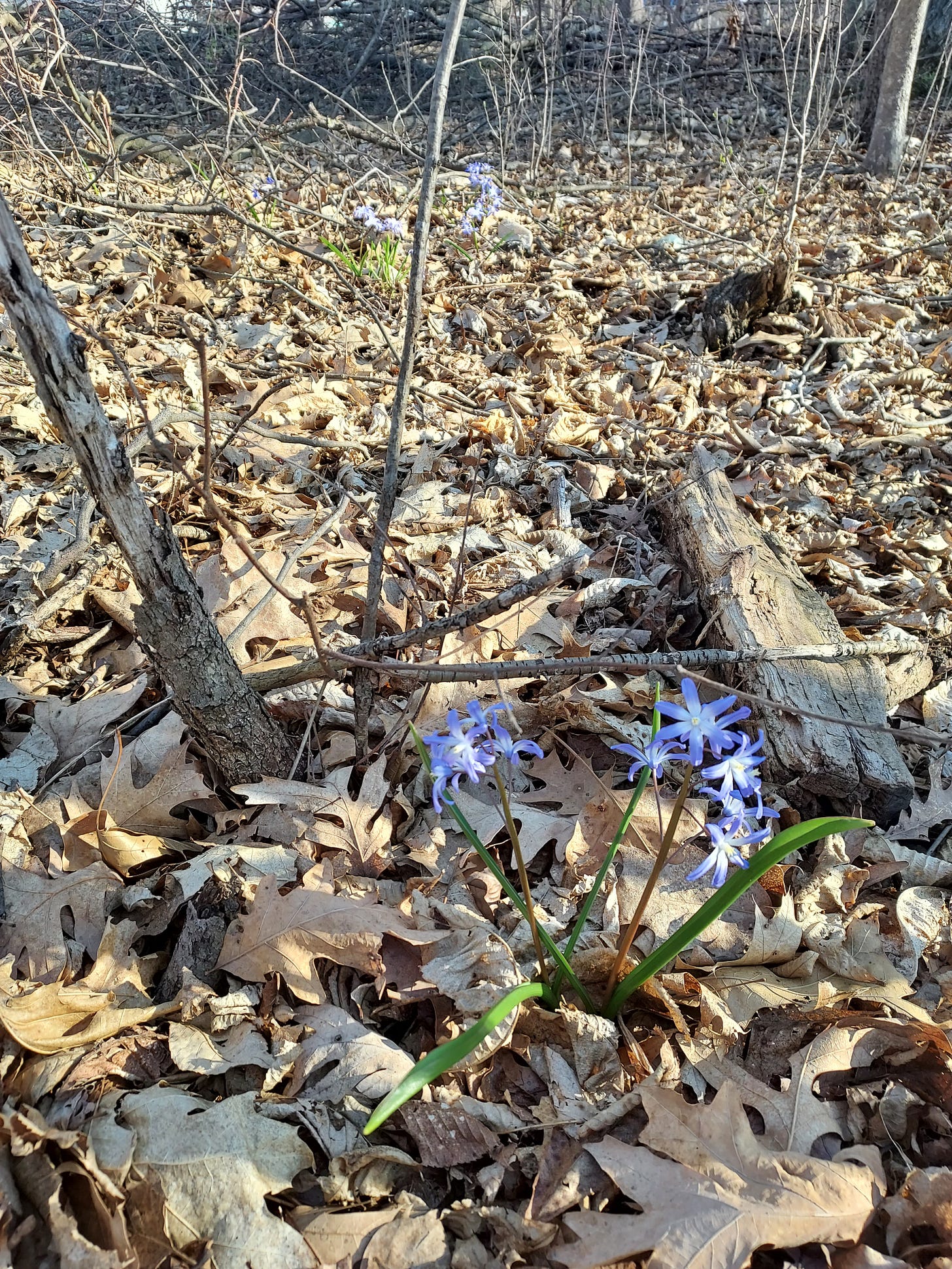
people do not, can not, and some will not understand THERE IS NO SUCH THING AS MILD COVID
NO WINNERS. All "spike", infection or injection, did damage. Even "mild to moderate" covid caused "brain changes" i. e. brain shrinkage / damage via British before and after covid brain scans study. When will studies showing Mrna spike brain damage be allowed to be published in "Nature"? This evil covid time is one of a continuum of infection / injection damage.
From those few who were able to choose the never infected or injected sequestered monk "no antibodies" path possible with the avoidance of "shared air" supplemented with before masking homemade oral/nasal antiviral sprays - 3M N95 "real" mask use - post real mask use of such antiviral sprays and homemade antiviral nasal flushes / mouth washes / gargles and antiviral eye washes and prophylactic antiviral nebulization and immune system supplementation - to the few able to obtain real treatments for covid once infected to the millions of infected / injected who suffered needless injury and death - NO WINNERS
"SARS-CoV-2 is associated with changes in brain structure in UK Biobank"
https://www.nature.com/articles/s41586-022-04569-5
"Importantly, these imaging and cognitive longitudinal effects were still observed after excluding the 15 patients who had been hospitalised"
"Brain changes after COVID revealed by imaging"
https://www.nature.com/articles/d41586-022-00503-x
"It is surprising that Douaud and colleagues identified these brain changes, given that most people in the case group experienced mild to moderate symptoms of COVID-19. Even when the authors excluded from their analysis the small number of people who required hospitalization, the results did not change. The researchers provide supporting evidence for the specificity of their findings by showing that similar changes did not occur in a group from the benchmark repeat-imaging study who contracted non-COVID-19-related pneumonia between scan sessions."
I wonder if a ketogenic diet would help by providing more ketones to replace the glucose that is lowered. Works with some other neurological conditions especially epilepsy.